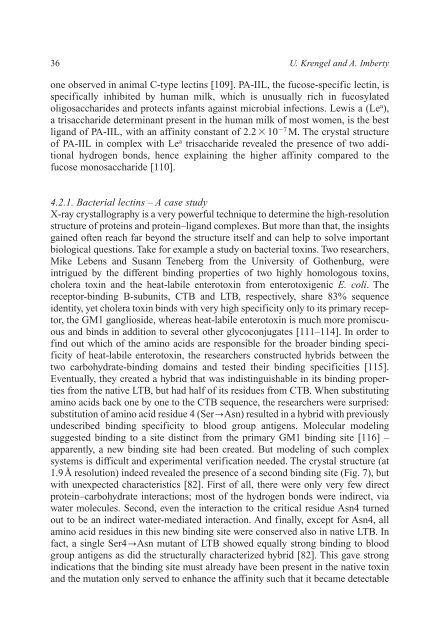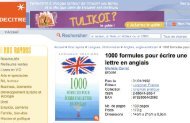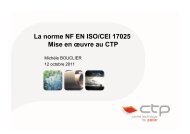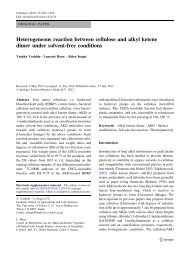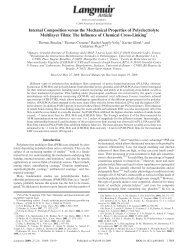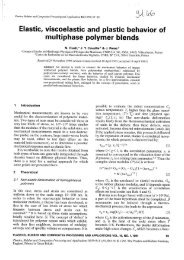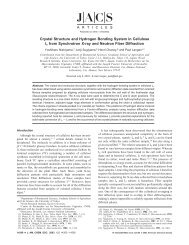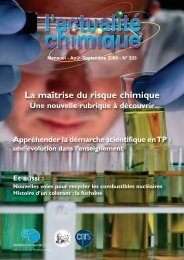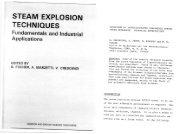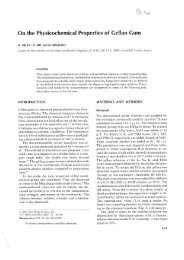Crystallography and Lectin Structure Database - CNRS
Crystallography and Lectin Structure Database - CNRS
Crystallography and Lectin Structure Database - CNRS
Create successful ePaper yourself
Turn your PDF publications into a flip-book with our unique Google optimized e-Paper software.
36 U. Krengel <strong>and</strong> A. Imberty<br />
one observed in animal C-type lectins [109]. PA-IIL, the fucose-specific lectin, is<br />
specifically inhibited by human milk, which is unusually rich in fucosylated<br />
oligosaccharides <strong>and</strong> protects infants against microbial infections. Lewis a (Le a ),<br />
a trisaccharide determinant present in the human milk of most women, is the best<br />
lig<strong>and</strong> of PA-IIL, with an affinity constant of 2.2 10 7 M. The crystal structure<br />
of PA-IIL in complex with Le a trisaccharide revealed the presence of two additional<br />
hydrogen bonds, hence explaining the higher affinity compared to the<br />
fucose monosaccharide [110].<br />
4.2.1. Bacterial lectins – A case study<br />
X-ray crystallography is a very powerful technique to determine the high-resolution<br />
structure of proteins <strong>and</strong> protein–lig<strong>and</strong> complexes. But more than that, the insights<br />
gained often reach far beyond the structure itself <strong>and</strong> can help to solve important<br />
biological questions. Take for example a study on bacterial toxins. Two researchers,<br />
Mike Lebens <strong>and</strong> Susann Teneberg from the University of Gothenburg, were<br />
intrigued by the different binding properties of two highly homologous toxins,<br />
cholera toxin <strong>and</strong> the heat-labile enterotoxin from enterotoxigenic E. coli. The<br />
receptor-binding B-subunits, CTB <strong>and</strong> LTB, respectively, share 83% sequence<br />
identity, yet cholera toxin binds with very high specificity only to its primary receptor,<br />
the GM1 ganglioside, whereas heat-labile enterotoxin is much more promiscuous<br />
<strong>and</strong> binds in addition to several other glycoconjugates [111–114]. In order to<br />
find out which of the amino acids are responsible for the broader binding specificity<br />
of heat-labile enterotoxin, the researchers constructed hybrids between the<br />
two carbohydrate-binding domains <strong>and</strong> tested their binding specificities [115].<br />
Eventually, they created a hybrid that was indistinguishable in its binding properties<br />
from the native LTB, but had half of its residues from CTB. When substituting<br />
amino acids back one by one to the CTB sequence, the researchers were surprised:<br />
substitution of amino acid residue 4 (SerAsn) resulted in a hybrid with previously<br />
undescribed binding specificity to blood group antigens. Molecular modeling<br />
suggested binding to a site distinct from the primary GM1 binding site [116] –<br />
apparently, a new binding site had been created. But modeling of such complex<br />
systems is difficult <strong>and</strong> experimental verification needed. The crystal structure (at<br />
1.9Å resolution) indeed revealed the presence of a second binding site (Fig. 7), but<br />
with unexpected characteristics [82]. First of all, there were only very few direct<br />
protein–carbohydrate interactions; most of the hydrogen bonds were indirect, via<br />
water molecules. Second, even the interaction to the critical residue Asn4 turned<br />
out to be an indirect water-mediated interaction. And finally, except for Asn4, all<br />
amino acid residues in this new binding site were conserved also in native LTB. In<br />
fact, a single Ser4Asn mutant of LTB showed equally strong binding to blood<br />
group antigens as did the structurally characterized hybrid [82]. This gave strong<br />
indications that the binding site must already have been present in the native toxin<br />
<strong>and</strong> the mutation only served to enhance the affinity such that it became detectable


